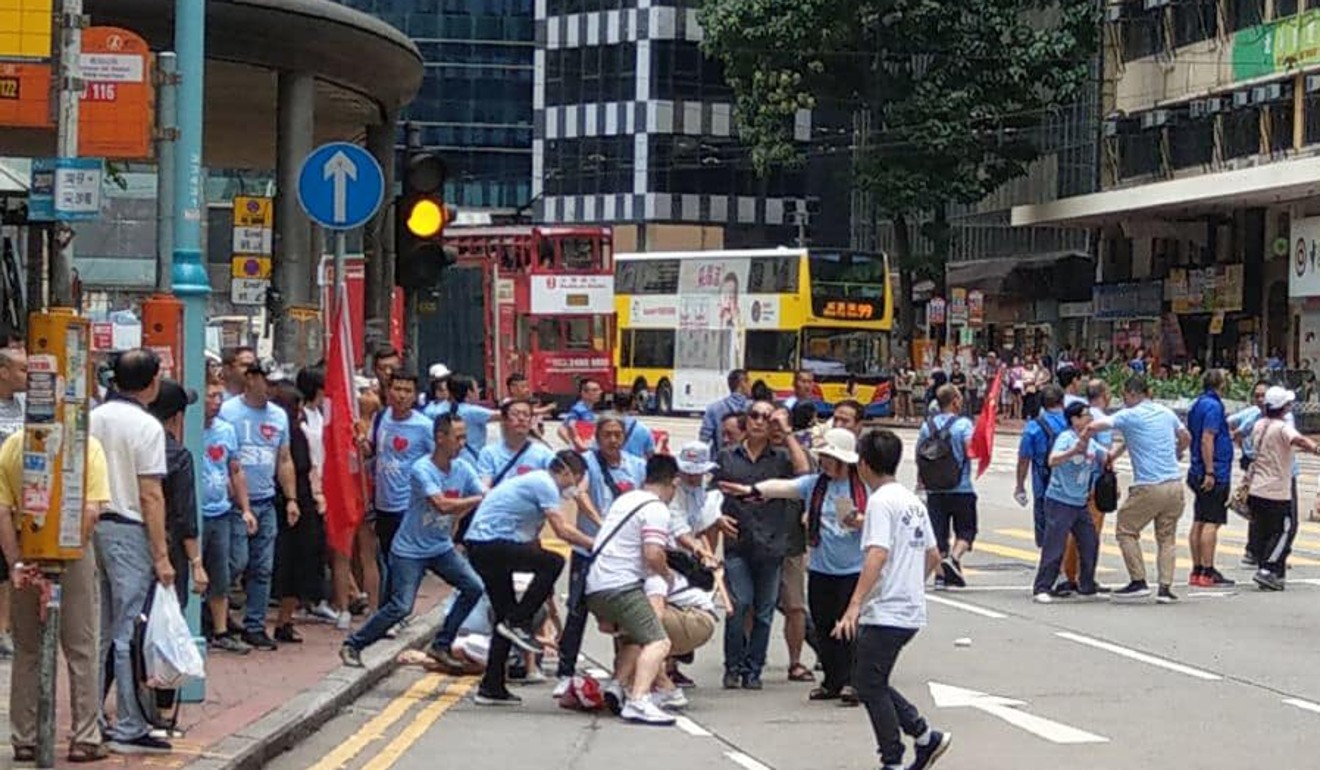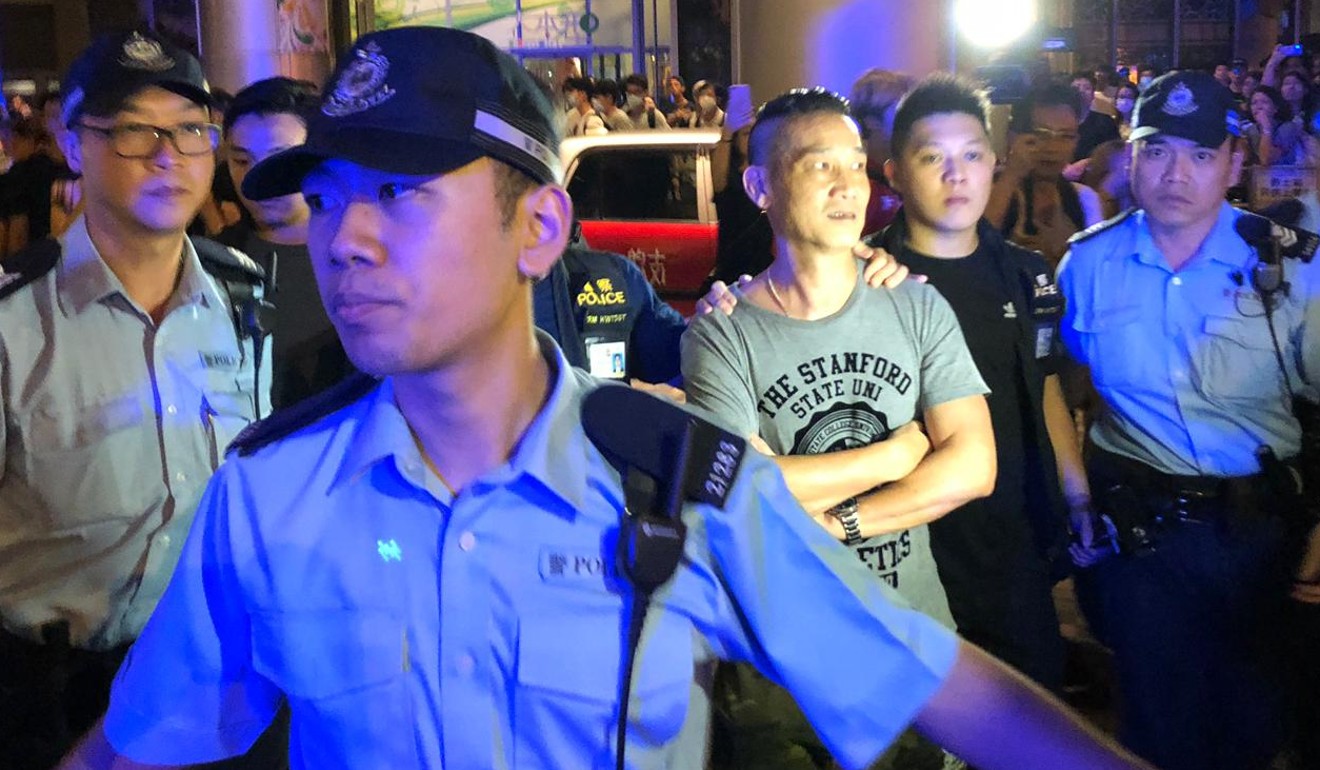
From vandalising MTR stations to setting off petrol bombs, now Hong Kong protesters are going for fist fights or ‘si liu’ to settle scores with rival groups
- New line advocates physical retaliation against aggressive groups rather than retreating or asking police to mediate and enforce the law
- Call comes on top of an array of tactics protesters have been deploying over the past months, each appearing more violent than before
The growing use of force by anti-government protesters in Hong Kong took a new turn over the past weekend, with vigilantism being advocated as a way to tackle clashes with rival groups. As the city marked the 15th straight weekend of demonstrations, protesters adopted a new phrase – si liu – which is Cantonese for “resolving things privately”.
The line advocates physical retaliation against aggressive groups rather than retreating or asking police – whom many widely view as their enemy – to mediate and enforce the law.
Previously, clashes in Tsuen Wan, North Point and Yuen Long had involved groups of older men attacking black-clad protesters.

Over four days, from last Saturday to Tuesday morning, more than 140 discussion threads about fighting back were posted on LIHKG, an online forum frequented by protesters.
Some threads, including the one that called for people not to aim at heads during such fights, had more than 1,000 comments.
But for a month before Saturday, there were only about 50 discussion threads on the same subject. The call for fist fights comes on top of an array of tactics that anti-government protesters have been deploying over the past months, each appearing more violent than before.
Tear gas fired amid street brawls between rival camps in North Point
In the early weeks, they used metal fences and barricades to block police and then turned to hurling projectiles, such as eggs, bricks, bottles and iron poles, and then resorted to laser pointers to affect the eyesight of officers training beanbag rounds at them.
They escalated their actions such that over the past few weeks, petrol bombs have become standard weapons used by the radical groups on the front lines.
In digital pamphlets circulated by the protesters, they said the railway had “betrayed” Hongkongers by shutting down train lines during mass protests and should be “sanctioned”. Another point of contention is the firm’s refusal to release security camera footage of a controversial police operation inside Prince Edward station on August 31.
Now, apart from such actions, the latest move is for protesters to take on physical combat, including using umbrellas or poles. They claimed this would only be in response to provocations and attacks by others, who had also used poles and sticks on them.
On Sunday, black-clad protesters and others in casual wear were seen fighting government supporters in various parts of town. At least five cases were documented, including of a man who was beaten by more than a dozen protesters after he allegedly hit someone in Fortress Hill.
Another man was beaten by a group in Wan Chai and was sent to hospital, police said on Monday.
In all instances, protesters insisted they were retaliating for attacks but these claims could not be independently verified.
On their forum, even as users supported retaliating against violent counterprotesters, there were others who counselled restraint. They cautioned that such physical acts could undermine support for the movement.

Other users said violence was only justified if protesters did not throw the first punch, noting that those in the movement had a responsibility in also keeping the peace.
“If we fight people over verbal arguments, how are we different from police and government supporters?” one user wrote.
The argument over using force against counterprotesters also happened offline.
On Saturday, two protesters were seen quarrelling in Amoy Plaza, Kowloon Bay, on how they should deal with a woman who they said had taken close-up pictures of demonstrators’ faces.
What are the weapons Hong Kong police use on anti-government protesters?
One argued that the woman should be let go, but was pushed to the ground by another protester, who said: “How can we treat them with leniency when some of our comrades were attacked with knives?”
Baptist University political scientist Edmund Cheng Wai said it was too early to judge if vigilantism had taken root among protesters, but conceded the situation was worrying.
“It is a sign of a collapse of trust in public institutions,” Cheng said, adding that some may feel police had not been impartial in their handling of protesters and pro-Beijing groups.
Cheng said it was possible that protesters would reflect and change their tactics, like they did after two mainland Chinese men were held up and assaulted at Hong Kong International Airport in August.
After the incidents, protesters decided to take a softer approach and defuse tensions by taking selfies with anyone they spotted taking photos of them.
The scholar also suggested ordinary Hongkongers might tolerate protesters’ acts of retaliation, given that they had been subjected to “gang-style” violence by civilians who indiscriminately beat up people.
“Protesters, journalists and bystanders are subjected to this kind of violence,” Cheng said.
Reporters, including two Post journalists, were among those attacked by a group of men in North Point on Sunday.
Meanwhile, protesters interviewed by the Post cited the police’s inaction against violence by their opponents as the reason they were taking matters into their own hands.
A male protester in his 30s, who declined to be named, said he was not involved in the fights on Sunday but would retaliate if attacked.
“Protecting yourself has become your own civic duty, there is no going back for Hong Kong,” he said, adding that retaliation might deter counterprotesters from launching further attacks.
He also claimed that in July, when scuffles broke out over a Lennon Wall in Yau Tong, police “escorted the pro-government people away and let them go”.
A social work student, who only gave his surname as Leung, said he understood why some protesters had resorted to brawling even though such acts were “undesirable”.
“The fact is police officers are impotent and have been condoning attacks against protesters,” said Leung, one of the demonstrators who had stormed the Legislative Council complex on July 1.
He said he drew the line at causing lives to be lost but did not set out how protesters could prevent such an outcome if things got out of hand.

Meanwhile, on Sunday, the use of petrol bombs was the main talking point again, with more than 80 such missiles thrown by radicals on the front line. Apart from barriers outside the government headquarters in Admiralty, the petrol bombs also hit the police’s water cannon truck, as well as a protester.
What next for Hong Kong’s extradition bill protesters?
MTR stations in Admiralty, Wan Chai and Tin Hau were also vandalised over the weekend.
A male protester in his mid-20s admitted both the demonstrators and police had deployed higher levels of force in recent protests.
“Petrol bombs are still the limit of protesters, but police are still using unlimited force and violence, acting like they were there to ‘shoot to kill’,” he said.
As for the obstacles and fires outside MTR station exits, he said they were set up to delay police and buy time for protesters to retreat.
University student Mavis Tai Ying-yee, 23, disagreed with the use of petrol bombs and vandalism at MTR stations.
“It’s excessive and useless because it won’t get protesters what they want,” she said.
The two demands that need to be met are the withdrawal of the bill and an independent inquiry into police’s handling of the protests, she added.
Additional reporting by Kimmy Chung, Jeffie Lam and Gigi Choy

